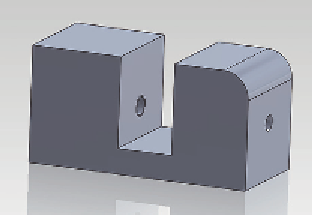Biomedical Engineering Reference
In-Depth Information
6 H5 THRO
M8 blind hole
Figure 8.20
Ill-conceived design with no thought for manufacturing.
model that works “on paper” but completely forgot how it is going to be made (not just made
but made efficiently and cheaply). How is the M8 hole to be machined? There is a piece of
metalwork in the way - and the 6 mm hole is not big enough to allow a tap to be introduced.
Hence the designer has not thought about how it is going to be made!
Now consider a component with several holes, all of different diameters. Are these
diameters really necessary? Can we reduce the number of diameters? “Why?” I hear you
ask. Because the operator (or the machine) has to change the drill for each hole, and this
wastes time and hence wastes money. Also the manufacturer has to stock all of the drills,
many times over. All of this adds to unnecessary cost that will drive up the cost of your
device. Do not forget, it is not only the material used in your actual component, you also
have to add how much scrap your produce: you pay for the scrap! As shown in
Figure 8.21
this can be very costly!
Once again, consider the component illustrated in
Figure 8.20
. Does the hole have to be such
a tight tolerance? Can its tolerance be lowered so that a more simple process can be used? A
general procedure to process these questions is illustrated by
Figure 8.22
.
How is the machine operator expected to hold the device? You may think this silly, but if you
are having your components coated then where they are held becomes important as that point
will have no coating!
You will notice that this is where communication with your potential manufacturer comes into
play. Failure to perform DFM is the main reason for most design failures at the prototype stage;
it is where you get the embarrassing phone call “and how do you expect us to make this?” If you
bring manufacturing expertise into play as soon as possible then DFM becomes very easy indeed.
Some questions to consider, in addition to those in
Table 8.7
, are:
l
How is it likely to be made (what process)?
l
Are there too many variations of design features?





Search WWH ::

Custom Search